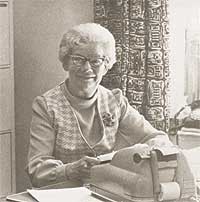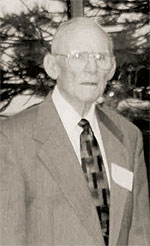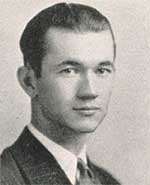Barbara
Shively 1919-2003
 Barbara
Shively, 84, lifelong resident of Burden, Kan., died Aug. 28, 2003,
in Winfield. From 1970 to 1979 when she retired, Shively was the financial
aid officer at Southwestern College. Ralph Decker recalls that during
the years Mrs. Shively was the financial aid director (and in those
days, the entire department) at SC, she realized that for some students
the financial aid system simply did not supply adequate funds. Barbara
made up the difference out of her own pocket and that is how many Moundbuilders
made it to graduation during her 10 years at SC. Some paid the loan
back, some did not. Ralph recalls Mrs. Shively saying, "When they
did not pay it back it just meant that I could not help as many the
next time around." While working at Southwestern, she also began
working at the Walnut Valley Festival office where she continued until
1999.
Barbara
Shively, 84, lifelong resident of Burden, Kan., died Aug. 28, 2003,
in Winfield. From 1970 to 1979 when she retired, Shively was the financial
aid officer at Southwestern College. Ralph Decker recalls that during
the years Mrs. Shively was the financial aid director (and in those
days, the entire department) at SC, she realized that for some students
the financial aid system simply did not supply adequate funds. Barbara
made up the difference out of her own pocket and that is how many Moundbuilders
made it to graduation during her 10 years at SC. Some paid the loan
back, some did not. Ralph recalls Mrs. Shively saying, "When they
did not pay it back it just meant that I could not help as many the
next time around." While working at Southwestern, she also began
working at the Walnut Valley Festival office where she continued until
1999.
E.
Dale Dunlap
E. Dale Dunlap, who was a faculty member
and academic dean at Southwestern College during the 1950s, died July
22, 2003. After he left Southwestern he became one of the founding faculty
members of Saint Paul School of Theology in Kansas City. From 1970 until
his retirement in 1987, he was academic dean of the seminary.
A well-known Wesleyan scholar, Dunlap was a leader in both the Kansas
West Annual Conference and the general church. A member of two General
Conferences and four Jurisdictional Conferences, he chaired the Ministry
Study Commission of the United Methodist Church and was a member of
the Committee to Study Baptism. He wrote the initial draft of what would
become known as “By Water and the Spirit,” the official
United Methodist understanding of baptism. In his latter years, he was
involved in advocacy for the rights of persons of same gender orientation.
“E. Dale Dunlap was an embodiment of the essential elements of
the Wesleyan tradition for the contemporary world,” says former
Southwestern College President Carl E. Martin. “He linked a passion
for social justice with an intellectual discipline that invited others
to follow. He was a compassionate leader, a dear friend and mentor.”
Dunlap is survived by his wife of 58 years, Frances Whitehead.
Two
men inducted into Southwestern College's Natural Science Hall of Fame
during April 2002 have died in the past few months.
 Harlan
Lenander Sr. ’39, a Sandia National
Laboratories scientist who helped develop a system protecting ships
from magnetic mines in World War II, died May 3, 2003. Following his
graduation from Southwestern, Lenander received a fellowship for graduate
study in magnetism at Duke University, but was recruited by the U.S.
Navy for its Magnetic Mine Protection program at the outbreak of World
War II. He later directed the testing of guided missiles at the Navy’s
China Lake Naval Base and then joined the technical staff at the Sandia
National Laboratory in Albuquerque, N.M. While at Sandia, he supervised
the testing of nuclear weapons on Eniwetok Atoll and later became director
of development, manufacturing, and testing for electromagnetic components
and systems. He retired as director of weapons applications. Lenander
was an active volunteer whose generosity included making standing tables
for disabled children. His survivors include his wife, Helen; they were
only four days away from their 60th anniversary when Lenander died.
Harlan
Lenander Sr. ’39, a Sandia National
Laboratories scientist who helped develop a system protecting ships
from magnetic mines in World War II, died May 3, 2003. Following his
graduation from Southwestern, Lenander received a fellowship for graduate
study in magnetism at Duke University, but was recruited by the U.S.
Navy for its Magnetic Mine Protection program at the outbreak of World
War II. He later directed the testing of guided missiles at the Navy’s
China Lake Naval Base and then joined the technical staff at the Sandia
National Laboratory in Albuquerque, N.M. While at Sandia, he supervised
the testing of nuclear weapons on Eniwetok Atoll and later became director
of development, manufacturing, and testing for electromagnetic components
and systems. He retired as director of weapons applications. Lenander
was an active volunteer whose generosity included making standing tables
for disabled children. His survivors include his wife, Helen; they were
only four days away from their 60th anniversary when Lenander died.
 Dee
F. Taylor ’40, Brooksville, Fla., died July 16, 2003.
Taylor received a fellowship in meteorology at the California Institute
of Technology, and then spent the next 35 years as a professional meteorologist
with the U.S. Navy and the U.S. Forest Service. He studied typhoons
with the Navy’s Pacific Weather Squadron on Guam and made 25 typhoon
penetrations. He later served in Washington, D.C. as commanding officer
of the Navy’s Fleet Weather Central, and then became director
of atmospheric science for the U.S. Forest Service. During his career,
he was active in research and authored more than 40 research publications.
After retirement from meteorology, Taylor invented a process that gave
sign manufacturers the ability to sharpen dull tungsten blades. Survivors
include his wife, Margaret (Seal) ’41.
Dee
F. Taylor ’40, Brooksville, Fla., died July 16, 2003.
Taylor received a fellowship in meteorology at the California Institute
of Technology, and then spent the next 35 years as a professional meteorologist
with the U.S. Navy and the U.S. Forest Service. He studied typhoons
with the Navy’s Pacific Weather Squadron on Guam and made 25 typhoon
penetrations. He later served in Washington, D.C. as commanding officer
of the Navy’s Fleet Weather Central, and then became director
of atmospheric science for the U.S. Forest Service. During his career,
he was active in research and authored more than 40 research publications.
After retirement from meteorology, Taylor invented a process that gave
sign manufacturers the ability to sharpen dull tungsten blades. Survivors
include his wife, Margaret (Seal) ’41.